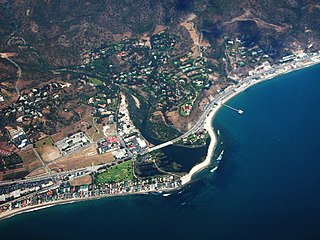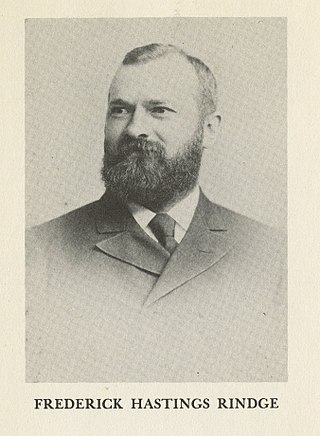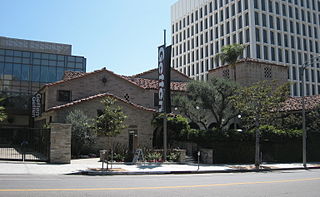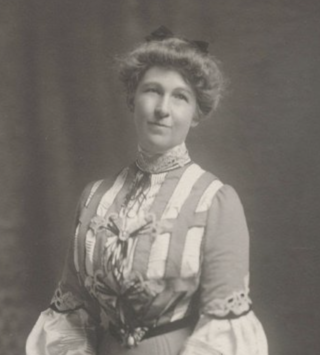
Malibu is a beach city in the Santa Monica Mountains region of Los Angeles County, California, situated about 30 miles (48 km) west of Downtown Los Angeles. It is known for its Mediterranean climate and its 21-mile (34 km) strip of the Malibu coast, incorporated in 1991 into the City of Malibu. The exclusive Malibu Colony has been historically home to Hollywood celebrities. People in the entertainment industry and other affluent residents live throughout the city, yet many residents are middle class. Most Malibu residents live from a half-mile to within a few hundred yards of Pacific Coast Highway, which traverses the city, with some residents living up to one mile away from the beach up narrow canyons. As of the 2020 census, the city population was 10,654.

Frederick Hastings Rindge (1857–1905) was an American business magnate, patriarch of the illustrious and prominent Rindge family, real estate developer, philanthropist, and writer, of Los Angeles, California. He was a major benefactor to his home town of Cambridge, Massachusetts and a founder of present-day Malibu, California.

Stiles Oliver Clements was an architect practicing in Los Angeles and Southern California.

The Geffen Playhouse is a not-for-profit theater company founded by Gilbert Cates in 1995. It produces plays in two theaters in Geffen Playhouse, which is owned by University of California Los Angeles. The Playhouse is located in the Westwood neighborhood of Los Angeles, California. It was named for donor David Geffen. The current executive director is Gil Cates Jr.
Rindge Co. v. County of Los Angeles, 262 U.S. 700 (1923), was a case in which the United States Supreme Court held that a county government could use its power of eminent domain to take land from a private landowner to build a scenic highway.
these roads, especially the main road, through its connection with the public road coming along the shore from Santa Monica, will afford a highway for persons desiring to travel along the shore to the county line, with a view of the ocean on one side, and of the mountain range on the other, constituting, as stated by the trial judge, a scenic highway of great beauty. Public uses are not limited, in the modern view, to matters of mere business necessity and ordinary convenience, but may extend to matters of public health, recreation and enjoyment. Thus, the condemnation of lands for public parks is now universally recognized as a taking for public use. A road need not be for a purpose of business to create a public exigency; air, exercise and recreation are important to the general health and welfare; pleasure travel may be accommodated as well as business travel; and highways may be condemned to places of pleasing natural scenery.

The Frederick Hastings Rindge House is a historic house located in the West Adams district of Los Angeles, in Los Angeles County, California.

The Adamson House and its associated land, which was known as Vaquero Hill in the 19th century, is a historic house and gardens in Malibu, California. The residence and estate is on the coast, within Malibu Lagoon State Beach park.

Art pottery is a term for pottery with artistic aspirations, made in relatively small quantities, mostly between about 1870 and 1930. Typically, sets of the usual tableware items are excluded from the term; instead the objects produced are mostly decorative vessels such as vases, jugs, bowls and the like which are sold singly. The term originated in the later 19th century, and is usually used only for pottery produced from that period onwards. It tends to be used for ceramics produced in factory conditions, but in relatively small quantities, using skilled workers, with at the least close supervision by a designer or some sort of artistic director. Studio pottery is a step up, supposed to be produced in even smaller quantities, with the hands-on participation of an artist-potter, who often performs all or most of the production stages. But the use of both terms can be elastic. Ceramic art is often a much wider term, covering all pottery that comes within the scope of art history, but "ceramic artist" is often used for hands-on artist potters in studio pottery.
Rancho Topanga Malibu Sequit was a 13,316-acre (53.89 km2) Spanish land grant in the Santa Monica Mountains and adjacent coast, within present day Los Angeles County, California. It was given by Spanish Governor José Joaquín de Arrillaga in 1804 to José Bartolomé Tapia.

Gladding, McBean is a ceramics company located in Lincoln, California. It is one of the oldest companies in California, a pioneer in ceramics technology, and a company which has "contributed immeasurably" to the state's industrialization. During the heyday of architectural terra cotta, the company "dominated the industry in California and the Far West."

Pacific Clay Products, founded 1892, was created by the merger of several Southern California potteries in the US. The company began producing utilitarian pottery in the 1920s, and introduced solid color earthenware dinnerware in 1932. The primary site for the production of ceramic tableware, kitchenware, and art ware was based in the company's Lincoln Heights, Los Angeles plant at 306 West Avenue 26. Pacific Clay ceased production of ceramic dinnerware and art ware in 1942. After 1942, Pacific Clay produced sewer tile and brick. The company ceased production of sewer tile in 1997. The company continues to produce brick products in Lake Elsinore, California. The company has been owned by David H. Murdock since 1973.

California pottery includes industrial, commercial, and decorative pottery produced in the Northern California and Southern California regions of the U.S. state of California. Production includes brick, sewer pipe, architectural terra cotta, tile, garden ware, tableware, kitchenware, art ware, figurines, giftware, and ceramics for industrial use. Ceramics include terra cotta, earthenware, porcelain, and stoneware products.

Malibu tile is a type of ceramic tile that takes its inspiration from the tiles that were produced at Malibu Potteries in Malibu, California, during the latter half of the 1920s. These tiles reflect a style of design that is referred to as Hispano-Moresque or Arabesque exhibiting bright contrasting glaze colors often in geometric patterns that are reminiscent of tiles produced many centuries ago in the Near and Middle East, North Africa and southern Spain. The Adamson House in Malibu, California, now the Malibu Lagoon Museum, contains the largest and most varied display of Malibu Potteries tile. The Adamson House was added to the National Register of Historic Places in 1977 and became a California Historical Landmark in 1985.

Ceramic art is art made from ceramic materials, including clay. It may take forms including artistic pottery, including tableware, tiles, figurines and other sculpture. As one of the plastic arts, ceramic art is one of the visual arts. While some ceramics are considered fine art, such as pottery or sculpture, most are considered to be decorative, industrial or applied art objects. Ceramics may also be considered artefacts in archaeology. Ceramic art can be made by one person or by a group of people. In a pottery or ceramic factory, a group of people design, manufacture and decorate the art ware. Products from a pottery are sometimes referred to as "art pottery". In a one-person pottery studio, ceramists or potters produce studio pottery.
Humaliwo was a Chumash village located in present-day Malibu, California. “Humaliwo” meant "where the surf sounds loudly". The village occupied a hill across from the lagoon in Malibu Lagoon State Beach.

The Hueneme, Malibu & Port Los Angeles Railway was a standard-gauge, 15-mile railroad in Malibu, California. It was founded by Frederick Hastings Rindge (1857–1905) and operated on his 13,000-acre ranch along the coast, which encompassed most of what is today Malibu. He struggled for years to keep trespassers off of his land, and feared that the Southern Pacific Company would use the power of eminent domain to build a railroad through his property. This threat animated Rindge to plan his own railroad to thwart the efforts of the Southern Pacific. This was part of his overall effort to keep outsiders off of his ranch and spoil what he considered to be paradise.

The Rindge family is an American family of British origin that was financially successful in real estate, natural resource development, and insurance.

Rhoda May Knight Rindge,, also known as May Rindge or May K., was an American businesswoman. She was known as the Queen of Malibu as well as the Founding Mother of Malibu and L.A.'s first high-profile female environmentalist. She holds the distinction of being the first woman to serve as president of a railroad company. Additionally, she founded Marblehead Land Company in 1921, and most notably, the Malibu Potteries in 1926, the first business in Malibu. The company originated Malibu tile, and the venture became one of Southern California's most successful of its kind alongside Catalina Pottery, Gladding, McBean, and Batchelder tile.
Rhoda Agatha Rindge Adamson also known as Rhoda Agatha Adamson or simply Rhoda Adamson, was the co-founder and secretary-treasurer of Adohr Farms and Adohr Dairy & Creamery, one of Southern California's largest and most successful dairies. She was the daughter of Rhoda May Knight Rindge and Frederick Hastings Rindge and wife to Merritt Huntley Adamson. She was alleged to be one the leading proponents of excluding African Americans and specifically Nat King Cole's family from Hancock Park, Los Angeles, according to "persistent rumors" reported by The Los Angeles Sentinel newspaper; an Adohr spokesman denied the rumors.
Rufus Bradley Keeler was a master ceramicist and ceramics glaze expert. He was plant superintendent of California China Products, a co-founder of California Clay Products (CalCo), and plant manager of Malibu Potteries. He was married to Mary E. Leary and had three sons and one daughter, including ceramicist Bradley Burr Keeler, who founded Brad Keeler Artwares and who came to be president of the California Art Potters Association and director of the California Gift and Art Association.














